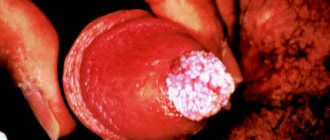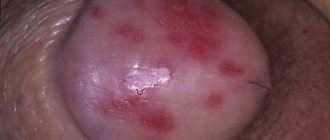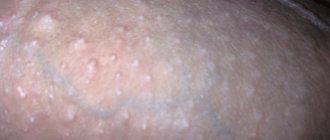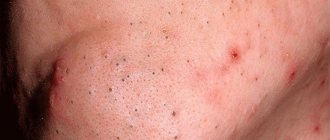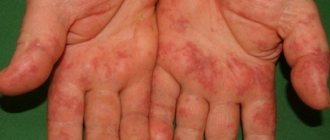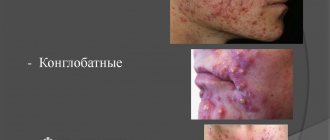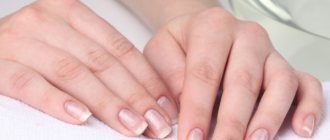Redness of the glans penis is considered a common complaint with which men seek help from a specialist. The cause of this pathological condition usually lies in infections that progress in the genitourinary system of the body.
Redness of the glans in men is often accompanied by the appearance of additional symptoms such as itching, pain, discomfort and problems with potency. This disease requires mandatory treatment, otherwise dangerous complications such as necrosis of the head and even cancer may develop.
Red head in men with nonspecific balanoposthitis
Most often, the reason why the head is red is that it is inflamed.
What causes this inflammation is a different question.
Of course, the doctor must find out the origin of the disease, using all the necessary and available diagnostic techniques.
Often red spots are caused by nonspecific balanoposthitis.
In men, it develops as a result of excessive growth of opportunistic bacteria.
This is a group of microorganisms that live on the surface of the skin.
They are present there either constantly or from time to time (transient flora).
However, in a normal body they do not cause problems.
Because the proliferation of bacteria is constantly inhibited.
On the one hand, our immunity does this.
On the other hand, the bacteria themselves compete with each other, preventing one of the species from excessively increasing its population.
But sometimes microbes still multiply, and then inflammation begins.
This often occurs against the background of provoking factors:
- hypothermia;
- injury;
- decreased immunity;
- insufficient hygiene;
- taking or local use of drugs, etc.
The risk is higher in patients with diabetes mellitus, immunodeficiency, as well as in those taking medications that negatively affect the immune system (glucocorticoids, cytostatics).
The appearance of red spots is one of the main symptoms.
Possible subjective sensations:
- pain;
- itching;
- tingling.
On examination, swelling is noted.
Red rashes on the head tend to merge.
The spots grow along the periphery.
As a result, the man's entire head may become red.
In other cases, the inflammation may appear as small red dots.
A mild form of balanoposthitis can even go away on its own.
Especially if the man has excluded predisposing factors.
For example, he began to wash himself more often and more diligently, stopped having too intense sex, and no longer uses medications that are harmful to colic or immunity, which he previously bought for himself at the pharmacy.
If the red pimples on the head do not disappear, you need to see a doctor.
Especially if the symptoms progress or do not regress within 2-3 days.
Inguinal fungus (athlete's foot) in men and women: causes, signs, diagnosis, how to treat
Athlete's groin is a chronic disease caused by a fungus that affects the epidermal layer of skin mainly in the groin area.
The main morphological element of the pathology is a scaly pink spot with pustular rashes located along the periphery. The lesions itch and cause discomfort to patients.
Athlete's groin is a delicate disease that leads to sexual dysfunction, decreased libido and sexual arousal.
The disease affects men more often than women. In children and adolescents, the pathology develops extremely rarely. The spread of fungal infection occurs through household contact through direct contact, through household items, personal hygiene products, and cosmetics.
With a decrease in the general resistance of the body, a primary focus is formed at the site of entry of the pathogen, which gradually grows along the periphery and spreads to healthy skin. The main location of the fungus is the inguinal folds.
In more rare cases, the disease can affect the skin of the buttocks, scrotum, perineum, penis, inner thigh, and pubic area. In women, the skin under the mammary glands, in the armpit and popliteal fossa often becomes inflamed.
Fungi of the genus Epidermophyton floccosum settle in the epidermis of the skin, destroy and utilize collagen, which leads to a decrease in the elasticity of the skin. Microorganisms have a low degree of pathogenicity, so the disease rarely develops in healthy people with full immune protection.
The diagnosis of pathology is made after microscopic detection of fungal mycelium in scrapings from the surface of spots and obtaining the results of bacteriological examination of biomaterial from patients.
Groin fungus requires a patient and careful approach. Causal treatment involves the use of antimycotic drugs that can completely cure the disease.
Etiology
Athlete's foot is a dermatomycosis caused by the fungus Epidermophyton floccosum. This is an anthropophile that grows and develops only on the human body.
It is located in the scales of the epidermis and nail plates. Under a microscope, fungal spores and well-branched mycelium are determined in skin scrapings.
After isolating a pure culture, the mycelium becomes yellow and the spores look larger.
Fungi are resistant to environmental factors. They grow and develop quickly at high humidity and temperature.
The infection spreads through contact and household contact through contaminated household items, as well as through touching and shaking hands. For rapid growth and development of fungi, moisture is necessary. Excessive sweating in a patient significantly increases the risk of infection.
In medical, preventive and public institutions, neglect of sanitary norms and rules can provoke an entire epidemic of mycosis.
Factors contributing to infection:
- Hyperhidrosis,
- Stress,
- Skin microtraumas
- Tight clothes,
- Obesity,
- Failure to comply with sanitary rules and regulations,
- Decreased immunity
- Hormonal disbalance,
- Metabolic disorders.
Symptoms
single spot of athlete's foot
With inguinal athlete's foot, pink or red-brown spots appear on the skin, having a round shape and a diameter of no more than one centimeter. The spots are located symmetrically, itch, peel and gradually grow.
Along the periphery of the spot on hyperemic and edematous skin, multiple blisters, pustules, suppurations, crusts and small flaky inclusions appear. Foci of inflammation are limited to an edematous ridge.
Plaques can merge with each other, forming a single erythematous area that spreads to surrounding tissues. Itching and burning are especially felt when walking, squatting and while bathing.
As the inflammatory process subsides, the central part of the spot becomes clean, pale and slightly sunken. This gives foci of epidermophytosis a special appearance of rings and is a pathognomonic sign of pathology.
Fungus in the groin in men itches and burns, and severe discomfort occurs when walking. The areas are painful to the touch. Vesicles and pustules can burst, forming erosions and ulcers.
When a secondary bacterial infection occurs, severe complications develop.
athlete's foot inguinal in men and women
Additional symptoms of athlete's foot include swelling of the groin area, hyperemia of nearby skin, and the appearance of specific blisters with turbid serous fluid.
With epidermophytosis, not inflammatory, but allergic rashes - epidermophytide - may appear on the skin.
They are located symmetrically, do not contain fungi and disappear on their own after undergoing antimycotic treatment.
In the absence of timely and adequate treatment, the disease can last for years. Athlete's disease is characterized by an acute or subacute course with pronounced signs of inflammation.
The disease quickly becomes chronic and takes on a wave-like course, during which periods of remission are replaced by exacerbations, forming from time to time new foci of skin lesions.
Even after complete recovery, the disease can recur.
Constant stress, friction in the affected area and hyperhidrosis complicate the course of the pathology.
Stages of the disease
- The initial stage is characterized by increased proliferation of the fungus in the epidermis and the appearance of pink spots with papules and vesicles on the skin.
- Clinical signs of the acute stage are weeping spots that grow, itch and are replaced by rings with scalloped edges.
- Chronic stage - lesions on the skin periodically lighten, and then become inflamed again under the influence of unfavorable factors.
- The advanced stage develops with a complicated course of the pathology.
If left untreated, large blisters appear on the skin, which become infected when damaged. The blisters are opened, necrotic tissue is removed and the wound is treated.
Diagnostics
Diagnosis and treatment of fungus in the groin area is carried out by dermatologists and mycologists. After collecting a history of the disease and listening to the patient’s complaints, they begin an external examination of the lesion and laboratory research methods. In some cases, consultation with an infectious disease specialist, venereologist, or immunologist may be required.
To confirm or refute the alleged diagnosis, it is necessary to conduct a microscopic and bacteriological examination of scrapings from the lesions for pathogenic fungi.
To do this, prepare a smear for microscopy and inoculate the test material on Sabouraud’s selective medium. The crops are incubated in a cooling thermostat at 22 degrees for 5 days. Saburo produces cream or yellow colonies with a round shape and fluffy consistency.
Microscopy reveals septate branching short mycelium and chains of rectangular spores.
Examination under a Wood's lamp will help exclude other diseases with a similar clinical picture.
Treatment
Treatment of inguinal athlete's foot is predominantly etiotropic. Since the disease is fungal, it is necessary to start taking antifungal drugs. Currently, the pharmaceutical industry produces a large number of effective ointments and creams.
Modern antifungal drugs - Lamisil, Mycoseptin, Clotrimazole. You can use Nystatin, Ciclopirox, Ketoconazole, Oxiconazole, Econazole. Complex ointments with an antifungal component and glucocorticosteroids are used in especially advanced cases.
They have a pronounced antipruritic, fungicidal, drying and antiseptic effect.
Treatment of inguinal fungus is carried out in the acute period, when the patient suffers from itching and burning. Antihistamines come to the rescue, eliminating irritation and discomfort in the groin - Cetrin, Zyrtec, Zodak, Diazolin.
After eliminating the symptoms of inflammation, the foci of epidermophytosis are treated with a Fukortsin solution, which has a fungicidal and antimicrobial effect. Patients are prescribed lotions with Resorcinol, sulfur-tar, Wilkinson and zinc ointments, Triderm.
A silver solution will help cope with inflammation and serous blisters. Local preparations are applied to inflamed areas 2 times a day. If the blisters reach large sizes, they are opened with sterile instruments.
Fungus in the groin should be treated for a long time, until the symptoms disappear completely.
During illness, the patient's immunity is greatly reduced. To strengthen it, it is recommended to use light immunostimulants - “Immunal”, “Imunorix”, “Licopid”. Complications of bacterial origin require treatment with antibiotics.
In the presence of extensive lesions, desensitizing therapy, antibiotic therapy, vitamin therapy, and autohemotherapy are carried out in a hospital setting.
If personal hygiene is not observed, drug treatment does not give a positive result. Patients need:
- Wash daily, paying special attention to the treatment of skin folds;
- Take baths with infusions of medicinal herbs that have anti-inflammatory and antiseptic effects;
- Wear loose underwear made from natural fabrics.
ethnoscience
Currently, there are a large number of traditional medicine recipes intended for the treatment of inguinal epidermophytosis at home.
- Infusion of St. John's wort, chamomile and lingonberry leaves is taken 100 ml daily for a month.
- Lotions made from a decoction of string, yarrow, and oak bark give good results. After the procedure, zinc ointment is applied to the skin.
- Radish seed pulp is applied to the affected areas of the skin.
- An alcohol tincture of poplar and birch buds is used to treat inflamed areas.
- Crushed celandine is applied to the lesions of inguinal athlete's foot for half an hour.
- Onion gruel helps get rid of pathology.
- A thick paste is prepared from soda, which is rubbed onto the affected skin.
- Ointment with essential oils is rubbed into the affected areas daily.
- Almond essence will help cure athlete's foot in the groin.
Prevention
Preventive measures to avoid the appearance of fungus in the groin:
- Disinfection of patient care items and common areas,
- Boiling and ironing linen, socks, shoe treatment,
- Use of removable shoes in baths and saunas - slates or rubber slippers,
- Fighting sweating
- Regular hygiene procedures,
- Wearing underwear made from natural fabrics in hot weather,
- Daily treatment of skin folds with cologne, salicylic alcohol, resorcinol and powdering them,
- Examination of contact persons,
- Prevention of stress,
- Strengthening the immune system.
Without adequate treatment, the spots will not disappear, and the disease will only progress. At the first symptoms of inguinal athlete's foot, you should consult a specialist. Pathogenic fungi and foci of epidermophytosis on the skin grow rapidly.
The prognosis of the disease is favorable. Acute and chronic stages of inguinal athlete's foot respond well to therapy. Modern antimycotic drugs can prevent relapse and re-infection.
: redness in the groin due to athlete's foot
Why is the head of the penis red with gardnerellosis?
If the head of the penis is red after sex, an anaerobic infection may be the cause.
There are several causative agents.
The most common is Gardnerella vaginalis.
As you can see from the very name of this bacterium, it lives in the female vagina.
It gets on the male penis during sex.
And sometimes it causes red pimples on the head.
This condition is called anaerobic balanoposthitis.
It occurs quite rarely.
Because gardnerella does not take root in most men.
It either does not settle on the head at all, or there is an asymptomatic carriage lasting several weeks.
Then the bacterium dies, since the living conditions on the penis are unacceptable for it.
If, when gardnerella appears, red spots appear on the penis, most likely men have reduced immunity, diabetes or other predisposing factors.
The disease can occur in three clinical forms:
1. Lightweight.
There are red dots on the head of the penis or it is all hyperemic.
But the integrity of the skin is not compromised.
2. Moderate.
Erosion appears.
Ulcers occur less frequently.
This form of gardnerellosis occurs in individuals with reduced immunity.
While the mild form in immunocompetent individuals usually goes away even without treatment.
3. Heavy.
Occurs in HIV-infected people.
Severe purulent processes with tissue necrosis are observed.
Penile skin irritation
If the head and foreskin are red, this may indicate an allergy.
There is such a thing as allergic diseases of the genital organs. There are several risk factors for developing allergies: sexual and non-sexual. The first group of allergens includes seminal fluid, latex, spermicides, lotions, creams, antiperspirants and other products. The second group includes mainly medications. For example, itching of the foreskin and redness occur when taking sulfonamides, vaccines, and some vitamins. This occurs only in people with hypersensitivity.
A typical allergy is fixed erythema on the foreskin in men or the glans. It is characterized by the appearance of a dark red spot on the head of the penis, which disappears on its own after a few weeks. Very often allergic reactions manifest themselves as balanoposthitis. Allergies can occur due to improper hygiene. As a result, various salts, bacteria, and Smegma are found under the foreskin. The reaction to latex condoms is of great importance.
In this case, the focus of redness of the foreskin in men is limited to the area where the condom is located. Hyperemia does not spread to other areas. When you exclude its use, the redness on the foreskin and glans disappears. Similar symptoms are observed in some cases when using condoms made of other materials. They need to be selected individually.
When the head and foreskin are red, the quality of underwear matters. This is observed when using synthetic material. The area of redness on the foreskin quickly disappears. In this case, contact dermatitis is not observed. Redness on the head may be the result of an insect bite. An accompanying symptom is swelling.
Mechanical trauma
Any injuries or damage to the penis can occur due to excessively tight underwear made of rough materials or as a result of frequent and rather aggressive sex, especially when the partner produces little lubrication. At the same time, the representative of the stronger sex notes that the head of the penis is red and itchy, pain appears, which becomes more pronounced at the slightest touch and when visiting the restroom to relieve a minor need.
Hormonal imbalance in the body
Hyperemia of the head of the penis can occur due to disruption of hormone production. This is quite common in men aged 40 to 50 years.
The epithelium begins to gradually change due to a lack of hormones. The replacement of old cells with new ones does not happen quickly enough. Because of this, the skin becomes inflamed. Sometimes men complicate this process. In particular, they scratch the groin when they feel itching and thereby open the gates of infection.
Stages of the pathological process
Doctors distinguish several stages of development of balanoposthitis. However, the signs of the disease in each of them differ significantly:
- Simple form. At this stage, redness of the head of the penis appears. At the same time, it becomes swollen. Sometimes cracks appear in the area of the red spot, from which pus later begins to ooze.
- Erosive. The main symptom of this stage is a white coating on the surface of the penis. In some patients, enlargement of the lymph nodes occurs simultaneously with the appearance of plaque. The skin of the penis becomes thinner and dries out.
- Gangrenous stage. It develops without treatment. The first signs of its onset are numerous ulcers. Some of them are quite deep. Foci of necrosis are visible in certain areas of the penis. The patient complains of acute pain and weakness.
With the modern level of medicine, the gangrenous form of balanoposthitis is extremely rare. It is detected in very poor African countries. But doctors quite often diagnose the simple and erosive form in patients from developed countries.
Red spots on the head in men with candidiasis
Fungi are one of the most common causes of balanoposthitis in men.
Many doctors will think about a fungal infection first of all if they see red dots on the head.
Especially if the patient complains of itching.
Additional symptoms:
- sour smell;
- white deposits;
- rash (spots, papules).
As the disease progresses, the affected area increases.
Inflammation can spread to the foreskin and urethra.
Erosive elements and painful cracks appear.
Moderate or severe forms of candidiasis are observed mainly in immunodeficiencies or diabetes.
For most men, the disease is mild.
Only a red spot appears on the head of the penis and itching, which goes away after a few days on its own or under the influence of specific therapy.
Causes of pathology
There are many reasons that can cause redness of the glans penis, ranging from urogenital diseases to fungal infections.
Medical practice shows that most often this pathology is provoked by the following factors:
- Allergic reaction. Using detergents, wearing synthetic clothing and cosmetics containing chemicals causes men to develop allergic reactions. A man complains of redness of the head of the penis combined with itching and burning. To prevent and eliminate such manifestations, it is recommended to refuse to use detergents with fragrances and dyes, and to give preference to clothes made from natural materials. In addition, it is best to give preference to natural skin moisturizers and latex-free condoms.
- Increased dryness of the skin. Unpleasant burning, itching and redness of the foreskin of the penis can occur in men when masturbating or wearing tight underwear. It is possible to alleviate the patient's condition with the help of moisturizing creams and lubricants, which contain natural ingredients. At home, you can use Vaseline, which does not contain dyes or flavors.
- Psoriasis. Many men with this diagnosis suffer from redness and peeling of the skin of the foreskin. This symptomatology noticeably worsens during sexual intercourse or during masturbation, which causes severe discomfort to the man. You can get rid of such symptoms by following the rules of personal hygiene, using moisturizing creams and products containing vitamin A.
Hygiene
Violation of personal hygiene rules can provoke redness of the glans penis. In order to eliminate such a problem, a man needs to monitor the cleanliness of his penis and keep it clean. It is possible to keep the skin healthy and prevent its wear and tear with the help of special creams that should be used to lubricate the skin of the organ.
If a man has redness of the head and foreskin, the reasons may be the following:
- the accumulation of smegma in the foreskin is considered a favorable condition for the proliferation of pathogenic microorganisms;
- Promiscuous sexual activity, unprotected and oral sex;
- diabetes mellitus, in which the urine contains sugar, which becomes an ideal environment for the growth of bacteria;
- the presence of concomitant pathologies in a man, for example, trichomonas or gonorrheal urethritis.
Redness of the head of the penis often becomes a sign of a dangerous disease that can lead to unpleasant consequences. It is for this reason that if such a symptom appears, it is necessary to seek advice from a specialist.
- Fungal infections. Candidal balanitis is a condition in which the head of the penis becomes infected due to an overgrowth of the Candida fungus. This form of balanitis is more common in men who suffer from diabetes, AIDS, or have taken antibiotic medications that can cause an overproduction of yeast in the body.
- Contact dermatitis. The head of the penis can become irritated and inflamed due to harsh chemicals and irritants in products such as shower gels, soaps, or latex condoms. Switching to natural laundry detergents, sports cotton underwear, using skin moisturizers and hypoallergenic lubricants, and condoms made from other materials can help relieve genital pain and reduce inflammation and redness.
- Some drugs. Medicines such as painkillers, laxatives and antibiotics can cause various redness on the skin and cause itching of the foreskin.
- Bacterial infections . In addition to yeast infections, which can cause inflammation, factors such as stress, poor hygiene and climate change can upset the balance of bacteria that live under the foreskin and around the genital area. This can cause bacteria to multiply and cause an infection.
- Traumatization . Cuts, bruises, or injuries to the glans penis can cause the skin to become swollen and more susceptible to infection.
Dry skin can turn into an additional factor of irritation during masturbation or sexual intercourse, which also leads to a feeling of discomfort. Men with cracked penis pores and surrounding skin may find benefits from using a chemical-free moisturizer, which can affect the rate at which the skin heals and relieve dryness and irritation.
Men who suffer from psoriasis elsewhere (not in the genital area) can identify the appearance of this condition on the head of the penis and skin by a number of additional signs, including redness, peeling and itching, which lead to self-doubt in addition to discomfort during sexual intercourse. Penile care options using products containing vitamin A can be effectively used for therapeutic purposes and can stop the development of genital psoriasis.
Of course, STDs, along with HPV and herpes, can cause purple bumps and discomfort during sexual intercourse. For men who have been diagnosed with an STD, it is very important to abstain from sexual intercourse until examined by a doctor, undergoing tests and undergoing therapeutic measures.
In addition, there is a fairly wide variety of infections caused by bacteria or fungi that can affect the condition of the skin of the penis, causing it to become red, sometimes rash, and also painful.
Cracked pores can allow microorganisms to find openings to penetrate through the outer skin, causing symptoms that are mistakenly interpreted as an STD.
Likewise, infections like Candida can cause pink bumps or rashes, itching, and peeling skin pores. Treatment for this condition depends on the type of infectious agent. The most effective way to combat this is to keep your pores and skin clean by using a clean moisturizer.
Allergy and redness of the head of the penis
It is the most common non-infectious reason why the head of the penis is red.
Multiple spots appear on it.
Sometimes it is one spot (a characteristic manifestation of fixed erythema).
Associated symptoms:
- itching;
- less often pain;
- serous discharge.
Sometimes the red color of the head of the penis remains the only symptom.
Allergy without itching is often observed.
Especially if it was caused by a weak allergen.
If the head of the penis is red and itchy, your doctor will examine you for infection anyway.
Because they are more common than allergies.
But once the allergic origin of the disease is confirmed, the best treatment is to avoid further contact with allergens.
Red head due to penis injury
The likely reason why red dots appear on the head of the penis is trauma to the penis.
Most often this happens during sexual intercourse.
Multiple dots mean that your friend recently had hair removed in her intimate area, but it has already begun to grow back.
Upon contact with them, simultaneous skin irritation occurs in different places.
During sex, this may not be felt or noticed.
But after it, the skin of the head of the penis is red, slightly swollen, and sometimes even painful.
However, if there are no infections, the problem will go away on its own after a day or two.
Occasionally, a man manages to seriously injure his penis during sex.
Then not only red spots appear on it, but also erosions and bruises.
In such a situation, you should consult a doctor and take measures to prevent infection.
Methods for preventing the disease
Poor personal hygiene can lead to unpleasant symptoms in the penis and foreskin, especially in uncircumcised men.
In order to avoid this problem, it is very important to monitor your penis and keep it clean. Uncircumcised males should remember the importance of regularly cleaning the foreskin of dirt. The use of cream for intimate areas can restore the normal state of pores, as well as protect the skin of the genital area from difficulties associated with diaper rash, infections of bacterial or fungal origin, as well as various redness. The main cause of balanoposthitis among children is the reduction of the foreskin, when it is not possible to pull it back. This is a dangerous condition that promotes infection and redness.
Redness of the genitals is also observed among adolescents who tend to ignore hygiene procedures and, as a result, there is an accumulation of too much smegma, which collects under the head of the penis and causes not only redness, but also a burning sensation. There is a high risk of complications and the emergence of chronic forms of diseases among children, since adolescents do not always share their problems with their parents and do not consult doctors in a timely manner.
Share
Red head of the penis and itching due to STDs
Genital infections rarely cause inflammation of the glans.
Much more often they penetrate the urethra, causing urethritis in men.
However, with most STDs, spotting is likely.
This could be gonorrhea, chlamydia, trichomoniasis.
Peculiarities:
- occur after sex, 1-3 weeks later;
- The disease begins with urethritis, and only then the inflammation can spread to the head of the penis.
Some sexually transmitted infections almost always cause a rash on the penis.
These are their main, not additional symptoms.
Let's look at these diseases in more detail.
Causes of redness of the penis and foreskin
Redness on the head and foreskin occurs due to an infectious lesion:
- The most common cause of inflammation is candidiasis, that is, tissue damage by the Candida fungus. The patient's main complaints are itching, burning, and minor pain. Upon examination, erosions limited by a white coating are found on the skin of the organ.
- Sexually transmitted diseases (chlamydia, genital herpes, etc.) are often asymptomatic, but with some infections erosion and redness occur on the head. In this case, the patient complains of frequent urination, itching, burning, tingling, small rashes, and discharge from the urethra.
- Nonspecific bacteria often provoke redness of the head of the penis. The foreskin and head of the organ swell, and small cracks appear on them. Balanitis and balanoposthitis are often accompanied by specific discharge.
Redness on the head of the penis is also caused by the following non-infectious causes:
- Dermatological skin diseases:
- lichen planus – lilac or pinkish itchy spots form on the skin;
- with eczema, dry skin, itching and redness bother you;
- allergic dermatitis is an inflammation of the skin that occurs upon contact with an allergen (the head and flesh not only turn red, but also swell);
- Queyre's disease is characterized by lesions of areas of the skin with their redness.
- Medicines, namely salicylates, anticonvulsants and warfarin. When taking these medications, the redness on the head is clearly limited, large blisters often form, after opening which ulcers form. The same damage is present on the mucous membranes of the eyes and mouth. They disappear quickly after discontinuation of the drug.
- In some men, redness on the head of the penis occurs due to exposure to mechanical or chemical irritants. They are found in soap, gel, lubricants, spermicides, washing powders, and synthetic underwear. In this case, redness occurs on the head without itching. Tight underwear can rub the skin and cause irritation, which becomes an entry point for infection.
Predisposing factors to the appearance of pathology:
- diabetes;
- phimosis;
- genital injuries;
- medical procedures (urinary catheter);
- unprotected sex.
Allergy
Allergic reactions occur not only to chemical hygiene products, lotions, creams, but also to medications (sulfonamides, antibiotics). A characteristic symptom is local round redness on the organ, which goes away on its own after stopping contact with the allergen and taking an antihistamine.
If a man notices redness after using a condom, then he should change it to a product of a different brand. When wearing tight synthetic underwear, the skin in this area sweats and rubs, causing irritation. You should wear loose cotton underwear.
Balanitis and balanoposthitis
Balanoposthitis, as well as balanitis, are the most common causes of inflammation of the head and the flesh around it. The main symptoms of these pathologies:
- redness on the head of the penis;
- itching and swelling of the tissues of the foreskin;
- the formation of small ulcers on the skin;
- phimosis;
- severe pain during urination;
- When it lasts for a long time, discharge with an unpleasant odor appears.
These diseases usually occur due to poor hygiene. The risk of morbidity increases with sexual intercourse with insufficient lubrication, anemia, diabetes and STIs. The worst thing is if the inflammation is accompanied by burning, itching and copious discharge from the urethra. This indicates the presence of infection and threatens the development of epididymitis, prostatitis and urethritis.
The severity of inflammation and the presence of other symptoms depend on the stage and type of disease:
- Redness on the head occurs with uncomplicated balanoposthitis. Phimosis and swelling are also present.
- In the erosive form, redness is complemented by the appearance of large ulcers, an unpleasant odor and lightened areas with dead tissue.
- The most dangerous gangrenous balanoposthitis. Local manifestations are supplemented by general intoxication, fever, and headaches. There are swelling and ulcers on the skin of the organ.
Candidiasis
In addition to redness, candidiasis in men is accompanied by itching and burning. A whitish coating is noticeable on the head of the organ, and a cheesy discharge leaves the urethra. The patient experiences discomfort and pain during sex and urination. Often the disease is complemented by cystitis, orchitis and urethritis.
The disease occurs when immunity is weakened, due to long-term treatment with antibiotics, stress, hypothermia, poor nutrition and after suffering from acute respiratory viral infections. Asymptomatic STIs (chlamydia, gonorrhea, trichomoniasis) can provoke candidiasis.
Herpes and redness of the head of the penis
Causes redness of the head.
But the clinical picture is not limited to this.
The next day, after redness and tingling appear, blisters appear.
There is liquid inside.
Depending on the severity of the disease, there may be more or less bubbles.
They have different sizes.
They often appear not only on the head, but also in other parts of the genital area.
Less commonly, the rash is not vesicular, but macular or papular.
Subjective manifestations:
- itching;
- pain;
- burning;
- tingling.
Symptoms appear about a week after infection.
Infection occurs during sexual intercourse.
There are rashes on the penis for 1-2 weeks, less often – up to 3 weeks.
They always go away on their own.
But if you start treatment right away, the disease will go away much earlier and the symptoms will be less severe.
This is important for the patient, since the pathology is difficult to tolerate.
Herpes infection is not completely cured.
Relapses are possible in the future.
Their frequency and severity correlates with the severity and duration of the primary infection.
And also with the state of human immunity.
The weaker it is, the longer and more often the patient will get sick.
Causes and signs with photos
Balanoposthitis
This pathology is characterized by the fact that the inflammatory process affects the head and foreskin . The cause of balanoposthitis is often non-compliance with hygiene standards for a long time, as a result of which sebum accumulates in the glands under the foreskin and it plays the role of a comfortable environment for activating the proliferation of pathogenic microorganisms.
In this case, the representative of the stronger sex is faced with itching and redness of the head and foreskin, which are not the only symptoms. The rest of the clinical picture includes acute pain in inflamed areas, enlargement and tenderness of regional lymph nodes, and a possible rise in body temperature .
In the absence of timely treatment, inflammation progresses, and the next stage of the disease is the appearance of gradually suppurating erosions. If erosive processes are not treated, necrosis of the inflamed skin develops.
Urethritis
The inflammatory process starts in the urethra, which is where the name of the disease comes from, and is associated with the growth and reproduction of opportunistic flora, which became more active due to disturbances in the microflora of the penis or due to a weakening of the body due to infectious diseases.
In this case, there is pronounced redness, itching of the glans penis in the urethra and burning during urination , the glans is swollen and all these symptoms are accompanied by pain in the area of inflammation and, in some cases, the appearance of rashes in the groin.
Candidiasis
The cause of the development of candidiasis is stressful situations, diseases accompanied by intoxication and weakening of the entire body, chronic diseases or infection with a colony of fungi. These factors are necessary for candida, which are representatives of opportunistic microflora and do not cause harm most of the time, to become pathogenic.
The clinical picture includes itching and redness of the head of the penis, the appearance of a white coating on the inflamed area, as well as a peculiar sourish, yeast-like odor from the genital organ.
Video about candidiasis on the head:
Herpes
This pathology is quite dangerous and can often lead to infertility; it is provoked by a virus and its presence remains asymptomatic for a long time.
Then minor exacerbations occur and the virus goes into remission, lasting several years.
During an exacerbation, men notice that red pimples have appeared on the head and their appearance is accompanied by itching. In addition to the itching, a strong burning sensation is sometimes observed.
The main thing for a man in this situation is not to start itching, as this will cause the rash to spread to neighboring areas, that is, to the buttock, inner thighs and anus. If left untreated, this rash will develop into ulcers, which appear between days 6 and 56 of illness and are accompanied by fever and enlarged regional lymph nodes.
Pediculosis
When a red rash appears on the head and it itches, a man may think about the presence of pubic lice, since such symptoms are the result of bites from these parasites.
Infection with them is possible not only through sexual intimacy, but also in everyday life, through the sharing of personal items, such as towels, bed linen, washcloths and especially clothes.
Lichen
When lichen occurs in such an intimate place, the first thing that appears is papules that look like red dots, accompanied by itching.
However, this rash does not always look like a classic red dot; it can be:
- Ring-shaped.
- Horn-shaped.
- In the form of complex geometric shapes.
- Bubbly.
- Pigmented.
- Hypertrophic.
Shades can also vary and in addition to red, there are pink, brown and bluish formations. It is worth considering that at the beginning of the disease there are no symptoms, and they appear only with prolonged absence of treatment.
Lichen is quite specific, although it looks similar to other pathologies. In order to personally confirm this particular pathology, a man can lubricate the elements of the rash with vegetable oil. If this rash is the result of lichen, then a fine mesh will form on its surface.
Psoriasis
Men who have experienced psoriasis note that their scalp first peels and then peels off, and itching occurs most of the time.
These symptoms affect not only the head, but also the foreskin, and during sex or self-pleasure they worsen and cause greater discomfort, combined with psycho-emotional tension and awkwardness.
Sexually transmitted infections
Diseases transmitted during sexual contact are no less common, if not more common, than other pathological processes affecting the male genital organs. And most importantly, for them it is redness around the head and itching; it is these symptoms that initially attract the attention of a man.
Gonorrhea
From the moment of infection with gonococci, the course of the pathology is latent and does not bother the man until it enters the phase of exacerbation of the process.
After this, the pathology is manifested by the appearance of redness and itching of the head of the penis, a burning sensation along the urinary canal, which intensifies when visiting the restroom to relieve a minor need.
In everyday life, a man’s life becomes difficult due to constant discomfort in the groin area.
Chlamydia and ureaplasmosis
Both of these pathologies are accompanied by redness, itching and a burning sensation. In addition, there may be rashes affecting the organs of the reproductive system and the skin next to them. In some situations, there is an increase in body temperature and general signs of illness, such as weakness, aching muscles and bones, and similar symptoms.
For more information about the causes of itching and redness on the head, watch the video:
Redness of the head of the penis due to syphilis
Syphilis manifests itself in the initial period as erosion, which most often occurs on the penis.
First, a small spot appears on the head.
It increases along the periphery.
It also begins to rise above the surface of the skin, turning into a papule.
After a few days it ulcerates.
Erosion appears on a solid base of cartilaginous density.
The erosion itself is red, but the top is covered with a yellow or gray coating.
There is no pain.
The lymph nodes in the groin are enlarged, but do not hurt.
Diagnosis of redness of the head of the penis
If a red dot or spot appears on the head, or the entire male organ turns red, there are many reasons for this.
Therefore, before treatment it is necessary to be examined.
It is impossible to determine by symptoms alone what caused the inflammation of the penis.
Sometimes the doctor can guess the cause.
But in any case, he must confirm his guesses in the laboratory.
Because without knowing exactly the origin of the disease, it is very difficult to plan treatment.
If your glans penis is red, your doctor will most likely prescribe:
- microscopic examination of a scraping or fingerprint smear (if there are deposits);
- PCR for sexually transmitted infections;
- sowing from the head to the flora;
- blood test for allergies.
Many inflammatory processes do not arise as a result of infection during sexual intercourse, but due to impaired carbohydrate metabolism or reduced immunity.
Therefore, patients are advised to evaluate immunogram parameters, blood tests for sugar and glycated hemoglobin.
Especially if they have been diagnosed with diseases associated with immunodeficiency states:
- gardnerellosis and other types of anaerobic balanoposthitis;
- often recurrent herpes;
- candidiasis;
- recurring nonspecific bacterial balanoposthitis.
If the red spot is a single erosion, it may be syphilis.
The patient donates blood for antibodies.
A scraping is taken from the surface of the erosion for PCR testing.
There are a large number of tests that a doctor can prescribe for patients with red spots on the penis.
But this does not mean that they are all assigned at the same time.
The doctor conducts indicative studies, and only after that evaluates the feasibility of using certain diagnostic methods.
During microscopy, he can detect signs of existing inflammation.
If it is present, a search is conducted for the causes of the inflammatory process.
It can be caused by fungi, specific or nonspecific bacteria.
Already during microscopy, some pathogens can be detected.
For example, Candida fungi or multiple opportunistic bacteria (coccal, rod microflora).
It is impossible to determine its appearance microscopically.
But you can do a flora culture, and then the doctor will know not only the type of the main pathogen.
He will also receive information about which antibiotics to treat the patient to achieve the best result.
Because after sowing the flora, it is assessed for sensitivity to various antibacterial agents.
PCR is mainly used to diagnose sexually transmitted infections.
A scraping is taken from the area where there are red dots or spots on the head.
This way you can identify herpes, syphilis, gardnerellosis, candidiasis, trichomoniasis and many other pathologies.
Irritation and itching between the legs in the groin in men
Itching and redness in the groin area in men causes a lot of inconvenience. In addition to the aesthetic appearance, the problem causes pain when walking, irritation from the touch of clothes and underwear.
To understand what ointment is needed if redness appears in the groin in men, it is necessary to understand the reasons.
Causes
A red spot on the skin in the groin area indicates the development of dermatitis. This most often occurs with excessive sweating of the groin.
The factors causing its appearance can be varied.
- Lack of "breathing". In hot weather, the sweat glands between the legs produce large amounts of sweat. Tight clothing and synthetic fabrics prevent access to fresh air, causing increased sweating. Such an environment is beneficial for the development of a bactericidal background and fungal infections.
- Violation of hygiene rules. The fungus can be transmitted through personal hygiene products such as towels, washcloths, and bar soap.
- Metabolism. Often, due to poor nutrition, hormonal changes, puberty, and taking medications, the natural metabolism in the body is disrupted. These changes can cause groin irritation.
- Endocrinological diseases. Damage to the skin can be observed with the appearance of such ailments as diabetes, obesity, and problems with the thyroid gland.
Men who notice signs of hyperhidrosis and redness between the testicles and leg should immediately consult a specialist. Timely detection of the disease and proper therapy will help get rid of the problem without causing complications.
Diagnosis by a doctor
If you have signs of skin diseases, you should consult a dermatologist. A certified doctor will be able to accurately diagnose the disease and prescribe effective treatment. During the examination, the doctor evaluates the area of distribution of lesions in the epidermis, the size and shape of the spots. In addition to the groin area, other common areas prone to hyperhidrosis should be examined.
If there is a risk of fungal or infectious diseases, scraping of the affected area of skin will be necessary. The analysis is sent for bacteriological or histological examination.
Having ruled out the bacteriological form of the disease, the dermatologist refers the patient for additional examinations to an endocrinologist, gastroenterologist, or neurologist.
Possible complications
Lack of timely treatment when irritation occurs in the groin in men can lead to the development of serious complications.
Skin susceptible to dermatitis with the intensive development of the disease may become covered with rashes, abscesses, small ulcers, and cracks.
If an infection occurs, simple red spots can develop into a serious inflammatory process. Diaper rash, lumps, itching appear, and soft tissues begin to peel off. This form of the disease requires local drug treatment.
Clotrimazole
The drug, aimed at combating fungal infections, includes clotrimazole and auxiliary substances such as: alcohol, paraffin, propylene glycol, cetomacrogol. Therapy lasts from 14 to 28 days, depending on the complexity of the disease.
The cream must be applied to a previously cleaned area of damaged skin. Before using the drug, the groin area is thoroughly washed with laundry soap or other hypoallergenic product, wiped dry with a towel and allowed to dry completely for a few minutes.
To prevent relapse, the product must be used for 10-14 days after the initial signs of the disease disappear.
Binafin
A homogeneous white cream designed to combat fungal infections. The active ingredient of the drug, terbinafine hydrochloride, in combination with starch, alcohol, paraffin and purified water, has a calming effect on areas of the skin damaged by the disease.
The drug is applied to reddened areas, twice a day. Before using the product, the groin area is washed with warm water, dried with a towel and dried. It is advisable to carefully remove keratinized particles and scales. The cream is applied with light massaging movements, lightly rubbing into the skin. The duration of therapy depends on the complexity of the disease and is 1-2 weeks.
Zinc ointment
A simple and affordable pharmaceutical product that produces the desired effect within a few days of starting treatment. Ointment based on zinc oxide has a softening and protective effect against external irritants. In addition, the drug relieves inflammation and dries out the affected areas of the skin.
For therapeutic purposes, the ointment is applied to areas with obvious symptoms of the disease in a thin layer 3 times a day. The course of treatment depends on the complexity and form of the disease and can last up to 2 months of continuous use. Zinc oxide does not cause significant side effects, so it is prescribed even to children over 3 years of age.
Traditional methods
Alternative medicine offers home remedies to treat irritations based on herbal ingredients. Baths with decoctions of medicinal herbs are effective in the fight against diaper rash and redness: sage, chamomile, St. John's wort, oak bark.
You can prepare a folk recipe for irritation in the groin area yourself. You will need the following oils:
- corn – 5 ml;
- olive – 5 ml;
- calendula – 10 ml;
- sea buckthorn – 5 ml;
- sunflower – 5 ml.
All components are poured into one container, mixed thoroughly and poured into a bottle with a tight lid. The bottle is placed in boiling water and kept at a low boil for 7 minutes, after which, without opening it, it is allowed to cool to room temperature.
The resulting product should be lubricated between the testicles and the leg 2 times a day, lightly rubbing it. The affected area is left open for 5-7 minutes so that the oil is absorbed into the skin.
Tips and tricks
To avoid irritation, itching, and redness of the groin area, men should adhere to hygiene standards. After intense physical activity, it is imperative to wash the lower part of the body with disinfectants.
You should not wear underwear that is too tight and restricts movement; it is also recommended to avoid synthetic fabrics.
How and how to treat redness in the groin in men quickly and effectively
One of the common problems that men suffer from is irritation that occurs in the groin area. Its symptoms are redness and itching, severe peeling, rashes, and an unpleasant odor. It is important to seek medical help in time. The doctor will tell you how and how to treat the change.
How to treat
Treatment for irritation between the legs depends on the cause of the disease. If the problem is caused by uncomfortable underwear, it is enough to replace it with a looser one and preferably made from natural materials. It is mandatory to adhere to the rules of hygiene - regular showers using hypoallergenic detergents and softening creams after shaving.
The main component of therapy is local treatment, which is carried out using antifungal ointments. The composition of such drugs includes clotrimazole, miconazole, retbinafine and other components.
Self-treatment of irritations before the examination is not recommended, as the problem can be caused by other reasons.
It is important to follow all prescriptions and instructions - this is the only way to completely recover from the disease. Treatment usually takes about two weeks, after which the redness in the groin disappears.
If you follow the rules of hygiene after this, the irritation will disappear forever.
If irritation is observed throughout the groin, the doctor prescribes antihistamines to the patient - Diphenhydramine, Suprastin, Diazolin, Pipolfen. As a rule, they are used in the acute stage of the disease.
Treatment can also be carried out using other drugs. For example, to eliminate a fungal infection, tinctures that are sold in pharmacies are used. This can be a solution of calcium chloride, resorcinol or silver nitrate. They are used to make lotions that are applied to the affected area. Irritation can be treated with sulfur-tar ointment.
Severe redness, accompanied by the appearance of pimples, signals a serious illness. Change may occur for the following reasons:
- Hidradenitis inguinalis – mechanical damage, weakened immunity, irregular washing. Treatment is carried out by treating damaged skin with antiseptics, taking immunostimulating agents, and following a diet.
- Psoriasis – reddish formations appear on the skin, which itch and may bleed. The pathology has not been fully studied and cannot be completely cured; it is only possible to achieve a state of remission, for which patients are prescribed antifungal creams and antibiotics.
- A boil is a pimple that gradually grows in size and has a purulent head. It is not recommended to remove pus yourself.
Red spots on the head in men: treatment
It is not the redness of the head or spots that are treated, but the disease that provoked the symptoms.
Therefore, therapy should be started only after a thorough examination.
Treatment will vary in different situations.
Sometimes the problem can be solved using local remedies.
In some cases, the use of tablets is required.
Sometimes you need to give injections and do various medical procedures.
Let's consider the main methods of drug treatment for diseases accompanied by the appearance of red spots and dots on the head.
How to anoint the redness on the head?
Local remedies can be used for:
- candidiasis;
- gardnerellosis;
- nonspecific balanitis.
Naturally, in cases where these diseases occur in a mild form.
If the severity is moderate, systemic medications are also used.
Because then the risk of complications increases significantly.
Traumatization of the penis also requires the use of local remedies.
Even if there is no infection, it may appear.
Because skin injury is an entry point for bacteria.
But in these cases, different drugs are used.
In case of head injury or nonspecific balanoposthitis, antiseptics are used.
For example, chlorhexidine or furatsilin is used.
If the bacterial etiology of the inflammatory process is established, the use of ointments with antibiotics is allowed.
Possible options:
- erythromycin;
- tetracycline;
- chloramphenicol.
But if it is a fungus, the use of antibiotics is not advisable.
Moreover, it can be harmful.
Because bacteria that compete with fungi die.
As a result, they grow faster and the inflammation worsens, spreads and risks causing complications.
If tests show that it is a fungus, you can apply one of the following products in the form of a cream to the penis:
- clotrimazole;
- miconazole;
- Butoconazole
On average, the course of treatment lasts a week.
If the disease was caused by gardnerella or another anaerobic infection, most antibiotics will not work either.
You need either clindamycin or one of the nitroimidazoles (for example, metronidazole).
Any other drugs are more likely to harm than help.
Allergies can also be treated with local remedies.
Hormonal ointments will help relieve symptoms.
But they should not be used for any infections!
Because these ointments suppress the immune system, and therefore, even if a short-term improvement occurs, in the future it may be replaced by a worsening of the situation.
What to drink when the head is red?
Oral medications are needed for:
- sexually transmitted infections;
- allergies (in addition to local treatment);
- moderate or severe form of any infectious balanoposthitis;
- herpes, even if it occurs in a mild form.
For allergies, antihistamines are usually taken internally.
They help reduce symptoms, although they do not eliminate the cause of the pathology.
In case of infections, different drugs are used.
It all depends on the specific pathogen.
For severe balanoposthitis, broad-spectrum antibiotics are often used.
It is optimal to make the choice on the basis of an antibiogram after culture.
If the drug is prescribed empirically, before receiving the results of the study, the antibiotic is subsequently changed.
Medicines for sexually transmitted infections:
- gonorrhea - cephalosporins (from tablet forms, cefixime is used);
- chlamydia - macrolides or tetracyclines;
- trichomonas, gardnerella – nitroimidazoles.
Oral forms of antiviral drugs for herpes are mandatory.
Local forms may not be used.
If they are used, they are only an addition to systemic therapy.
The patient is prescribed acyclovir.
It should be taken as early as possible.
If the start of treatment is delayed, the effect is significantly reduced.
In the future, the drug is used for each exacerbation of infection.
Types and symptoms
Signs and symptoms of balanitis may include:
- redness in the area around the head of the penis and flesh;
- inflammatory processes of various nature;
- soreness in the genital area;
- itching of the head and foreskin;
- unpleasant odors;
- irritation under the foreskin, usually occurring two to three days after intercourse.
Redness of the foreskin in men can be one of the symptoms of the following skin conditions and pathologies:
- Lichen planus with small, itchy, pink or purple spots on the arms or legs.
- Eczema is a chronic (long-term) skin condition in which the skin becomes red, cracked, and dry.
- Dermatitis is an inflammation of the skin that is caused either by direct contact with an irritant or by an allergic reaction. Eczema is known as eczematous dermatitis.
- Psoriasis – dry, scaly skin. The disease is believed to be genetically transmitted. It occurs as a result of a malfunction of the immune system.
Types of balanoposthitis:
- Catarrhal . This type of condition is characterized by local symptoms of inflammatory processes and softening of skin tone with the subsequent occurrence of erosion. Among the subjective sensations, males experience itching and burning. Purulent discharge may occur.
- Erosive . This condition manifests itself in the form of painful, deep red erosions with soaked edges on the head in men. Pain occurs in the affected areas, and subsequently the affected areas can cause phimosis. The lymphatic system is a conductor of infection; during transmission, local lymph nodes enlarge.
- Gangrenous . In addition to local manifestations, fever and fatigue may occur. Since the head and foreskin are deeply affected, purulent and necrotic ulcers appear, and phimosis develops against the background of the disease.
Red head in men: what to inject?
Sometimes the patient requires parenteral administration of drugs.
This is necessary if:
- the antibiotics used exist only in forms for parenteral administration;
- the patient has a high body temperature (this is possible with severe bacterial infections or herpes), so the absorption of antibiotics in the intestine may be impaired.
Syphilis and gonorrhea are treated with injections.
For gonococcal infections, ceftriaxone is prescribed.
This drug is more effective than oral cephalosporins.
For syphilis, penicillin is prescribed.
It does not exist in tablets because the antibiotic is not absorbed in the gastrointestinal tract.

